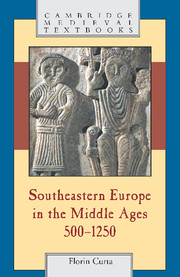Book contents
- Frontmatter
- Contents
- List of maps
- Acknowledgments
- Note on transliteration, names, dates, and words
- Chronology
- List of abbreviations
- Introduction
- 1 The end of Late Antiquity or the beginning of the Middle Ages (c. 500–c. 600)?
- 2 Southeast European “Dark Ages” (c. 600–c. 800)
- 3 The rise of new powers (800–900)
- 4 Iron century or golden age (900–1000)?
- 5 The first Byzantine century (1000–1100)
- 6 The second Byzantine century (1100–1200)
- 7 Between the Crusade and the Mongol invasion (1200–1250)
- 8 Conclusions and lingering questions
- Select Bibliography
- Index
- Cambridge Medieval Textbooks
6 - The second Byzantine century (1100–1200)
Published online by Cambridge University Press: 05 June 2012
- Frontmatter
- Contents
- List of maps
- Acknowledgments
- Note on transliteration, names, dates, and words
- Chronology
- List of abbreviations
- Introduction
- 1 The end of Late Antiquity or the beginning of the Middle Ages (c. 500–c. 600)?
- 2 Southeast European “Dark Ages” (c. 600–c. 800)
- 3 The rise of new powers (800–900)
- 4 Iron century or golden age (900–1000)?
- 5 The first Byzantine century (1000–1100)
- 6 The second Byzantine century (1100–1200)
- 7 Between the Crusade and the Mongol invasion (1200–1250)
- 8 Conclusions and lingering questions
- Select Bibliography
- Index
- Cambridge Medieval Textbooks
Summary
Throughout the twelfth century, the steppe corridor between the Dnieper and the Danube remained under the control of the Cumans, as part of what Arab and Persian sources called Desht-i Kipchak, the “Cuman Desert.” Given the absence of any twelfth-century source for the history of the medieval steppe lands similar to Constantine VII Porphyrogenitus' De administrando imperio, the exact disposition and names of the Cuman tribes remain unknown. However, judging from the many references to Polovcians (Russian term for Cumans) in the Russian Primary Chronicle, by 1100 or shortly after that, the power in the “Cuman Desert” was in the hands of Cuman chieftains in Right Bank Ukraine. Two of them, Boniak and Togorkan, had offered their military assistance to Emperor Alexios I Comnenus in the war against the Pechenegs. Boniak also led a raid against Hungary, which destroyed in 1099 a Hungarian army under King Coloman near Przemyśl, at that time in the western lands of the Rus' principality of Galicia. However, during the twelfth century, the Cuman tribes in Right and Left Bank Ukraine, respectively, ceased to be under a single leadership and, as a consequence, the Rus' princes of Kiev were capable of driving a wedge at the line of the Dnieper River. Writing in the mid-1100s at the court of the Norman king of Sicily, the Arab geographer al-Idrisi knew that the Dnieper separated the “Black Cumans” from the “White Cumans,” but that division illustrates less the true political fragmentation of Cuman power than Idrisi's scholarly approach.
- Type
- Chapter
- Information
- Southeastern Europe in the Middle Ages, 500–1250 , pp. 311 - 365Publisher: Cambridge University PressPrint publication year: 2006
- 1
- Cited by



